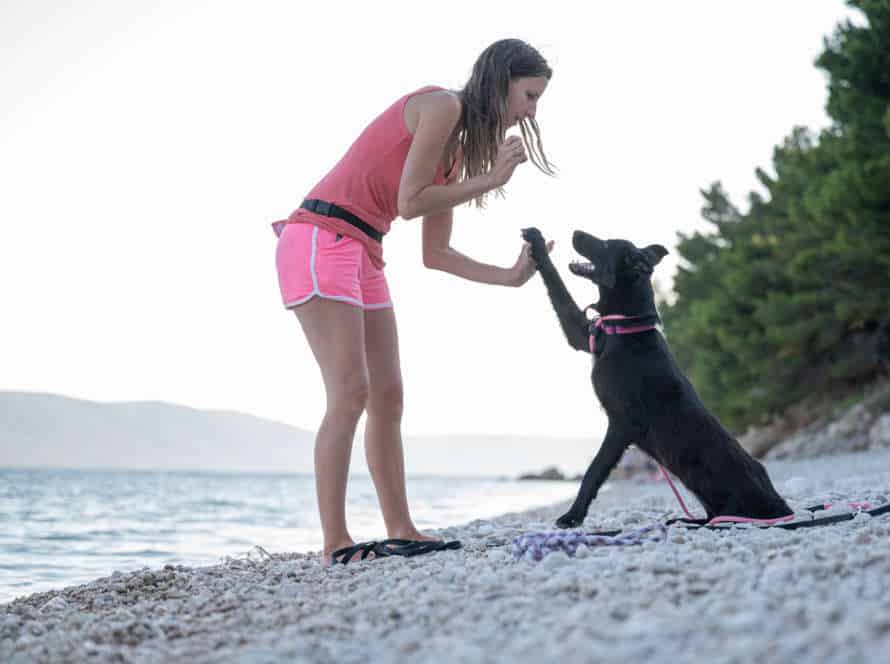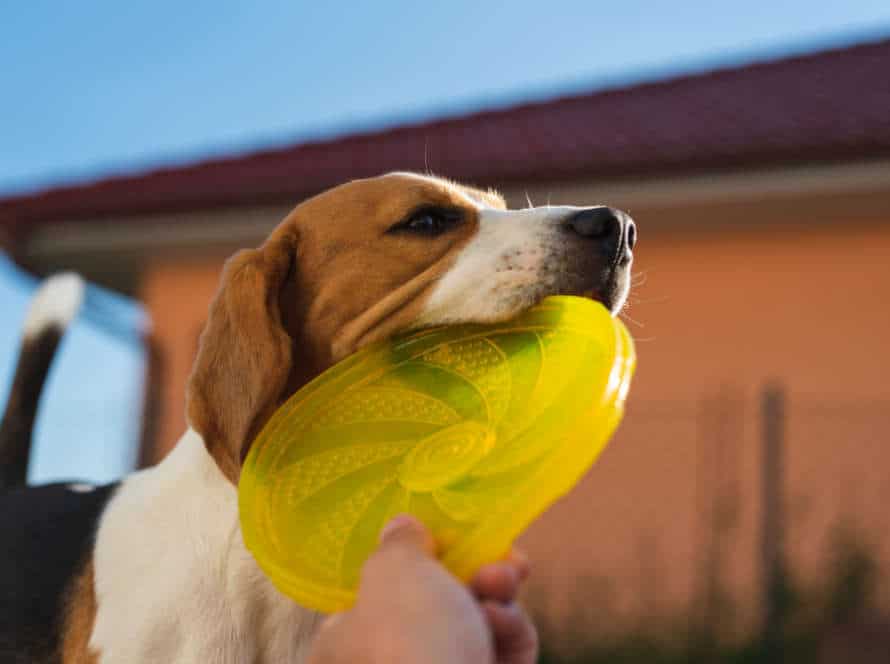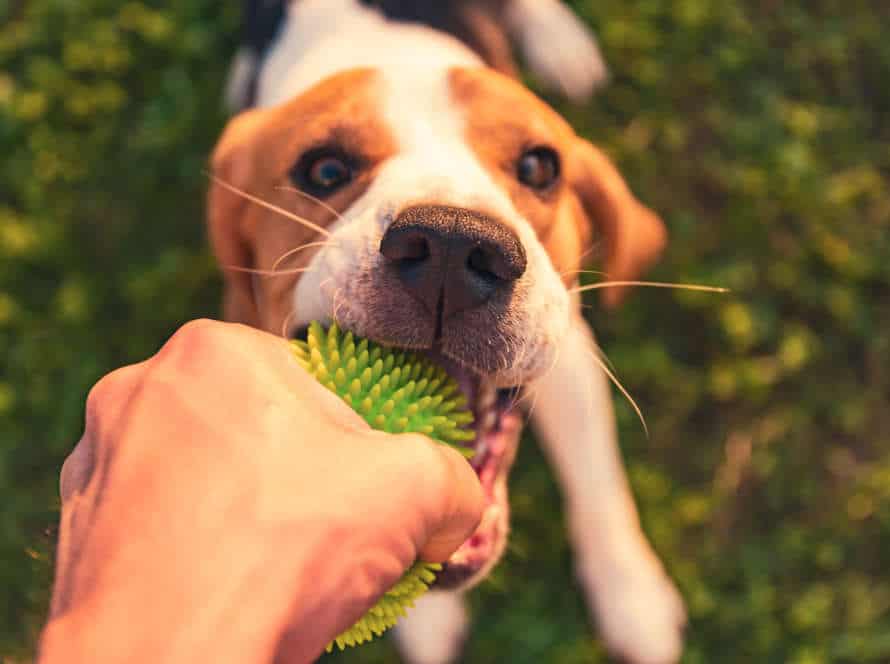When to End a Fetch Session: Signs of Fatigue and Overstimulation
Knowing when to finish playing fetch with your furry mate is a must for their physical and mental health. Watch for signs of fatigue and overstimulation, which can be bad for your pet.
Fatigue signs are: panting heavily, slowing down and lying down a lot. If they seem tired, take a break or stop the game.
Signs of overstimulation are: being very active, being fidgety and having trouble concentrating. If they seem too thrilled or can’t keep their behavior in check, take a break or end the session.
Remember to consider your pet’s age, health condition, and breed too, as it affects how long they can play. By spotting your dog’s behavior and knowing when to stop, you can keep them safe and content during playtime.
Understanding the Importance of Self-Regulation
Interacting with our pooches is essential for play and training. Self-regulation is important for them – the ability to know when something’s too little, too much, or just right. Especially important during a fetch session – you must know when to end it, so as to avoid fear, anxiety, or overstimulation.
In this article we’ll examine signs of fatigue and overstimulation in dogs. And how to finish a fetch session before it gets out of hand.
Defining self-regulation
Self-regulation is the power to manage our own feelings, behaviors, and ideas in response to circumstances. It means being in control, even when faced with tough or demanding events.
Recognizing and recognizing self-regulation is important to keep good mental wellbeing, strong personal relationships, and successful judgement-making.
It is likewise essential to train self-regulation methods in dog training to stop overstimulation and prevent possible injuries throughout activities like fetch.
Signs of exhaustion and overstimulation include panting, too much drooling, not listening to commands, and damaging behavior.
Knowing when to stop a fetch session is important to avoid overstimulation and stress in dogs, and promote healthy physical exercise habits for your pet.
By constantly keeping track of and handling self-regulation, we can build a more fulfilling and balanced lifestyle, both for ourselves and our furry friends.
Why self-regulation is important
Self-regulation is the capacity to manage one’s actions, feelings, and thoughts in reaction to different stimuli. It is a key factor for personal development and well-being. It also has a major influence on social relationships, academic accomplishment, and work performance.
Self-regulation skills help us with:
- Reining in our emotions and responses in difficult circumstances.
- Staying motivated and concentrated on our aims.
- Utilizing our time and resources effectively.
When it comes to our pets, self-regulation is just as significant. For example, when playing fetch with your dog, it’s important to observe signs of fatigue and overstimulation to avoid straining and injury. These signs may include heavy panting, difficulty in breathing, refusal to fetch, or disorientation. By watching out for these signs and finishing the session promptly, we support our dog’s self-regulation and lessen the risk of injury or sickness.
The relationship between self-regulation and overstimulation
Self-regulation and overstimulation are related. Knowing this can help you know when to stop a fetch game with your pup.
Self-regulation is the capacity to control feelings, thoughts, and actions. Dogs with strong self-regulation skills can better manage energy levels during playtime and avoid overstimulation.
Overstimulation happens when a dog’s energy level surpasses the capability to regulate thoughts and behaviors. This can bring about exhaustion, disappointment, and even aggression.
Signs of overstimulation in dogs include panting, too much drooling, less responsiveness to commands, and aggressive behavior.
If you observe these signs while playing fetch, it’s time to finish the game and let your dog rest.
By understanding the connection between self-regulation and overstimulation, you can help your pup learn how to manage energy levels and prevent overstimulation during playtime. Pro Tip: Give your dog breaks during playtime so they can rest and recharge.
Signs of Fatigue and Overstimulation in Dogs
Fetch is a wonderful way to keep your pup fit and active! However, keep an eye on their behavior. Too much stimulation or exhaustion can be risky. It may cause them to misbehave or even be aggressive. Knowing how to spot signs of overdone activity or fatigue will help you make sure every fetch session is fun and secure for both you and your doggo!
Physiological signs of fatigue and overstimulation
As a pup parent, it’s essential to notice signs of overstimulation and fatigue in your furry pal. Doing so helps you know when it’s time to end a game of fetch or other physical activity. Here are some common signs of exhaustion and overstimulation in doggos:
- Heavy panting or breathing difficulties
- Slower or reduced movements
- Stumbling or wobbly movement
- Not interested in play anymore
- Laying or sitting down, not wanting to keep going
- Shaking or trembling
- Wide eyes or dilated pupils
If you spot any of these signs in your pup, it’s time to call it quits and let them rest. Don’t forget, rest and recovery are just as important as play and exercise to keep your pup healthy and content.
Behavioral signs of fatigue and overstimulation
It’s key for pet owners to spot signs of fatigue and overstimulation in their pooches when they’re playing. Here are some common signs:
- panting heavily
- drooling too much
- slowing down
- being irritating or aggressive
- not focusing on commands
- eyes appearing glazed over
- excessive yawning or nipping
If you recognize any of these, it’s time to call off the play session and give your dog a rest. Too much exercise or stimulation can result in injuries, exhaustion or dehydration.
Pro Tip: Exercise and mental stimulation are vital for your pup’s health and happiness. Keep an eye on their behavior and adjust playtime as needed.
When to differentiate between fatigue and overstimulation
It’s a must for dog owners to know the signs of exhaustion and too much excitement. This stops injury, and looks after their pup’s wellbeing and comfort during playtime.
Exhaustion signs in dogs include slowing down, panting too much, laying down, not interested, and not obeying commands.
Signs of too much excitement in dogs are no rest, barking nonstop, biting or nipping, no focus, and running around in a wild way.
Once you see these signs, it’s time to quit the game. Pushing your pup too far can cause injuries. These include muscle strain, joint pain, swelling, and ligament damage.
Tip: Watch your dog closely when they’re playing. End it when they show exhaustion or too much excitement. Offer water, a comfy bed/blanket, and a well-balanced diet to help them get better.
Management Techniques to Prevent Fatigue and Overstimulation
Proper management’s a must for a successful fetch session. Recognizing when your pet’s overwhelmed or tired is key. To keep them safe and comfy, know the signs of fatigue and overstimulation. This section’ll discuss techniques to end a fetch session when needed.
Monitoring your dog’s body language
It is important to be aware of your pup’s body language to prevent fatigue and too much excitement during a session of fetch. This can cause health issues and injury, so it’s essential to stop the game before your dog gets too tired or overwhelmed. Here are some signs to look for:
- Heavy panting and drooling.
- Slow movements, lack of enthusiasm and decreased interest in the game.
- Limping or other signs of pain.
- Tail tucking or hiding, cowering.
- Wide eyes, raised fur, aggressive behaviour like growling.
By closely monitoring your dog’s body language and knowing when to end the fetch session, you can keep your pet healthy and happy. Pro Tip: Take breaks during playtime at regular intervals to give your pup a rest and stop overstimulation.
Providing adequate rest and recovery time
It’s key to give your pup enough rest and recovery time to avoid fatigue or overstimulation in fetch sessions. Signs of this could be:
- Rapid panting, drooling, or tongue out
- Slowing down, lying down, not wanting to play
- Disorientation, confusion, clumsiness
- Agitation, barking, jumping on people
When you notice these signs, give your pup a break. Put them in a relaxed spot, give them water, and let them fully rest before playing again.
Keep an eye on their behavior and body language during play, and adjust the frequency and length of fetch as needed. This will help stop overexertion and fatigue that can be bad for their health.
Implementing training drills to gradually build endurance
To keep dogs from feeling overstimulated or fatigued when playing fetch, it’s helpful to use training drills to build their endurance. These drills not only enhance physical health, but also reduce the risk of injuries and boost their energy. Here are a few drills to try:
- Increase distance gradually: Start with short distances and gradually increase as your pup’s stamina builds.
- Interval training: Split playing time into short, intense bursts of activity with longer rest periods in between.
- Speed and agility drills: Incorporate drills like weaving through cones or jumping over obstacles to improve performance and reduce boredom.
By adding these drills to their fetch routine, dogs can become more physically capable over time and avoid fatigue and overstimulation.
What to do if Your Dog is Fatigued or Overstimulated
Fetch is paw-sitively awesome for your pup! But it’s important to know when to call it quits. Your pup might get over-excited or too pooped if you keep playing. So watch out for signs of fatigue or overstimulation. Then, finish the session. This article will tell you how to recognize the signs and what to do when they appear.
How to recognize if your dog is fatigued or overstimulated
Recognizing if your pup is truly tuckered out or over-amped is key for their health and safety. Here are some signs to be aware of:
Fatigue:
- Your dog lounging often and not keen on standing or moving.
- Panting heavily and breathing rapidly.
- Dry snout and thick drool.
- Not showing interest in snacks or activities.
Overstimulation:
- Your dog is fidgety and can’t calm down.
- Abundant barking, leaping, and running.
- Wide-open eyes, panting intensely, and hyperventilating.
- Peeing or pooping in the house, even if house-trained.
If you notice any of these signs, it’s critical to stop the playtime or provide a quiet and secure place to rest. Offer them lots of water and consider reaching out to your vet if the symptoms continue. Remember, a healthy and cheerful dog means a healthy and merry home!
Strategies to calm an overstimulated dog
An overstimulated dog may show undesirable behaviors, like too much barking, biting, or chewing. To soothe them, try these strategies:
- Find and get rid of the cause of their overstimulation. This could be loud noise, other animals, or an unfamiliar setting.
- Create a peaceful space for them to rest. Make sure it’s far from any noise or disturbance.
- Give them calming aids, such as treats or supplements.
- Massage their ears, forehead, and shoulders.
- Plan exercise sessions and let them rest in between.
Pro tip: Exercise, training, and socializing consistently and regularly can help prevent overstimulation.
Understanding when to seek veterinary care for your dog
It’s essential for all dog owners to know when they should take their pup to the vet. While some issues can be managed at home, certain symptoms necessitate immediate medical attention to keep your pet healthy and safe.
A few usual warning signs to watch out for:
- Temperature surge
- Constant vomiting/diarrhea
- Weariness/fatigue
- Refusal to eat/drink
- Difficulty breathing
- Seizures/fainting
In addition, our pup’s behavior can give us insight into their wellbeing. If your dog is showing signs of fatigue or over-excitement during a play session, it’s time to stop and give them a break. If the behaviour or symptoms continue or worsen, veterinary help should be sought.
Bonus Tip: It’s always better to be proactive and consult your vet if you have any doubts or notice any changes in your dog’s behaviour.
Incorporating Self-Regulation in Your Dog’s Lifestyle
Want your pup to be well-rounded and confident? Incorporate self-regulation into their lifestyle! Training them to respond to stress and stimulation will help. It’s vital to recognize the signs of fatigue and overstimulation during a fetch session. Know when to end it before your pup becomes overwhelmed. Let’s explore the signs of fatigue and overstimulation. How to recognize them? Read on!
Tips for creating a balanced and regulated lifestyle for your dog
Give your pup a balanced and regulated lifestyle for their mental and physical wellbeing. Be aware of when to stop playtime. Signs of over-excitement or exhaustion for dogs can be panting, drooling, and confusion. End the session when you notice any of these. Exercise and engagement daily, a consistent routine, and lots of mental stimulation should be part of their lifestyle. This way, they can lead a content and healthy life, without going overboard.
The importance of routine and structure in preventing overstimulation
Dogs need structure and routine in their days to avoid overstimulation. This can cause fatigue, worry, and other health issues. Creating self-regulation in your pup’s lifestyle can help build a regular routine and structure that fits their physical, mental, and emotional needs.
When playing fetch, watch for signs of overstimulation and exhaustion. These include:
- Excessive panting
- Laying down and not getting the toy
- Slowing or hesitating to chase the toy
- Seeming disoriented or clumsy
- Becoming aggressive or too excited
By noticing these symptoms and stopping the fetching early, you can protect your doggy from overstimulation and make sure they stay happy and healthy.
Pro Tip: Provide your pooch with regular physical activity, mental stimulation, and breaks to keep a healthy routine and structure.
Understanding your dog’s individual needs for self-regulation.
Realizing your pup’s personal requirements for self-control is a must for their overall health and wellness. Incorporating self-regulation into your dog’s day-to-day life can stop exhaustion and overstimulation during fetch sessions. Here are some signs to keep an eye out for that tell you it’s time to end the game:
- Heavy panting: Excess panting is a symbol of overheating or tiredness. If your pup is panting heavily, it’s time for a break.
- Soreness or stiffness: If your pup is limping or becoming rigid, it’s probably time to finish the session.
- Loss of focus: If your pooch starts to lose interest in the game or gets easily distracted, it’s a sign of overstimulation.
- Disobedience: If your pup ignores your instructions or gets too excited or aggressive, it may be time to stop the game.
Knowing your dog’s conduct and personal needs for self-control is vital to keeping them content and healthy. Pro tip: Adding breaks and rest periods during playtime can help prevent fatigue and overstimulation.
Frequently Asked Questions
Q: How do I know when my dog is getting tired during a fetch session?
A: Signs of fatigue include slowing down, panting excessively, lying down, or refusing to continue playing.
Q: Is it safe to continue playing fetch if my dog is showing signs of fatigue?
A: No. Continuing to play fetch with an exhausted dog can lead to overexertion, dehydration, and potential injury.
Q: How long should a typical fetch session last?
A: A fetch session should last no longer than 10-15 minutes, especially for high energy dogs. It’s important to take breaks and let your dog rest in-between sessions.
Q: What are the signs of overstimulation during a fetch session?
A: Signs of overstimulation can include excessive panting, hyperactivity, lack of focus, and erratic behavior.
Q: How can I prevent overstimulation during a fetch session?
A: Keep fetch sessions brief, and take breaks if your dog shows signs of overstimulation. It can also help to play in a quiet, low-distraction environment.







